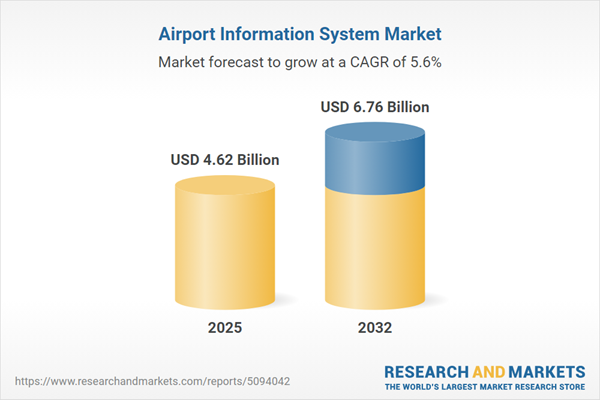Speak directly to the analyst to clarify any post sales queries you may have.
Airport information systems are becoming foundational for airports striving to balance operational efficiency, security, and passenger expectations in an evolving aviation landscape. Senior leaders seeking to futureproof their infrastructure need a data-driven view of technology trends, procurement dynamics, and regional opportunities now shaping this market.
Market Snapshot: Airport Information System Market
The global airport information system market is experiencing steady growth, reaching USD 4.39 billion in 2024 and projected to achieve USD 4.62 billion in 2025. The sector is set to accelerate at a CAGR of 5.55%, with market value expected to advance to USD 6.76 billion by 2032. This expansion is driven by automation, regulatory demands, and increased passenger flows.
Scope & Segmentation of the Airport Information System Market
- Component: Includes services such as consulting, support and maintenance, and system integration, as well as solutions comprising Airport Operational Database, Baggage Processing System, Flight Information Display System, Passenger Processing System, Resource Management Systems, and Security System Software.
- Size of Airport: Covers large, medium, and small hub airports, each with distinct needs and technology adoption drivers.
- System Type: Encompasses both airside and terminal side systems, addressing reliability and throughput optimization requirements.
- Technology: Features advanced tools such as Artificial Intelligence, Machine Learning, Big Data and Predictive Analytics, Biometrics, Blockchain, Edge Computing, and Internet of Things, supporting both predictive operations and enhanced passenger experiences.
- Deployment Mode: Incorporates on-cloud and on-premises models, each offering varying control, cost, and latency benefits.
- Application: Encompasses use cases from air traffic coordination, baggage and cargo management, logistics, emergency and incident response, and passenger processing to resource and security management.
- End-User: Addresses the needs of airline operators, airport authorities, government agencies, and ground handling service providers.
- Geography: Spans Americas (including the United States, Canada, Mexico, Brazil, Argentina, Chile, Colombia, Peru), Europe, Middle East & Africa (United Kingdom, Germany, France, Russia, Italy, Spain, Netherlands, Sweden, Poland, Switzerland, UAE, Saudi Arabia, Qatar, Turkey, Israel, South Africa, Nigeria, Egypt, Kenya), and Asia-Pacific (China, India, Japan, Australia, South Korea, Indonesia, Thailand, Malaysia, Singapore, Taiwan).
Key Takeaways for Senior Decision-Makers
- Integrated airport information systems are now core to digital transformation and resiliency, influencing operational control, compliance, and commercial outcomes.
- Rapid adoption of AI, edge computing, and biometrics is moving airports from static processes to predictive, automated operational models, driving new organizational capabilities.
- Flexible IT architectures with modular design mitigate risk from supplier changes and support rapid response to regulatory or trading environment shifts.
- Procurement decisions increasingly reflect the need for supply chain agility, including local collaboration, vendor diversification, and open standards to facilitate system interoperability.
- Competitive success depends on vendors' integration expertise, platform reliability, compliance guarantees, and the ability to work across legacy and next-generation systems.
- Distinct regional dynamics—from modernization cycles in the Americas to greenfield growth in Asia-Pacific and standards harmonization in EMEA—require tailored go-to-market strategies and technology partnerships.
Tariff Impact on the Airport Information System Market
Recent United States tariff actions in 2025 have redefined procurement and supply chain strategies for aviation technology. Airports and integrators are prioritizing modular system design, local sourcing, and multi-vendor partnerships to limit cost volatility and safeguard critical operations. These measures are shaping long-term investment planning, supplier engagement, and lifecycle management in hardware and hybrid solutions.
Primary Keyword: Airport Information System Market
Methodology & Data Sources
This report employs a robust mixed-methods methodology, combining structured interviews with airport IT leaders, airline operators, regulators, and vendors, alongside thorough document review. Triangulation of qualitative and quantitative insights ensures actionable, validated findings informed by industry best practices and up-to-date market realities.
Why This Report Matters
- Gain clarity on segment-specific opportunities and competitive positioning across the entire airport information system value chain.
- Evaluate technology adoption and procurement risks with a nuanced understanding of regional, regulatory, and geopolitical factors.
- Support strategic decisions by leveraging independently validated market insights for resilient, future-ready investments.
Conclusion
Strategic investments in modular, secure, and data-driven airport information systems are setting the direction for improved operational resilience and passenger satisfaction. Decision-makers equipped with these insights are prepared to adapt, innovate, and lead in a changing aviation market.
Additional Product Information:
- Purchase of this report includes 1 year online access with quarterly updates.
- This report can be updated on request. Please contact our Customer Experience team using the Ask a Question widget on our website.
Table of Contents
3. Executive Summary
4. Market Overview
7. Cumulative Impact of Artificial Intelligence 2025
Companies Mentioned
The companies profiled in this Airport Information System market report include:- Airport Information Systems Ltd
- Amadeus IT Group, S.A.
- Damarel Systems International Ltd
- Frequentis AG
- Fujitsu Limited
- Honeywell International Inc.
- International Business Machines Corporation
- Indra Sistemas, S.A.
- L3Harris Technologies, Inc.
- Leidos Holdings, Inc.
- Leonardo S.p.A.
- NEC Corporation
- RESA Airport Data Systems
- Saab AB
- Siemens AG
- SITA NV
- Tata Consultancy Services Limited
- TAV Technologies
- Thales S.A.
- Wipro Limited
- ADB SAFEGATE
- CGI Inc
Table Information
| Report Attribute | Details |
|---|---|
| No. of Pages | 194 |
| Published | November 2025 |
| Forecast Period | 2025 - 2032 |
| Estimated Market Value ( USD | $ 4.62 Billion |
| Forecasted Market Value ( USD | $ 6.76 Billion |
| Compound Annual Growth Rate | 5.5% |
| Regions Covered | Global |
| No. of Companies Mentioned | 23 |









